 We had our hands on the Sony Alpha A100 last week, Sony’s first step into the Digital SLR (dSLR) market.
We had our hands on the Sony Alpha A100 last week, Sony’s first step into the Digital SLR (dSLR) market.
We’ve known for a while that Sony and Konika/Minolta would be producing a dSLR, following Sony’s purchase of the traditional SLR company. The A100 is the first product of the deal.
Sony tell us that they see the market for dSLR’s growing by 30% over the next year, which is lucky as the compact digital market appears to be stagnating. They’ve got grand plans for this market, with their stated ambition to be ‘challenging for the top position’ by 2008.
The key message from Sony with the whole of the Alpha range is “We want to make you a better photographer.” Highly appealing to those who may be scared off by crossing over from a compact camera to the SLR world.
 What’s Hot
What’s Hot
Sony have brought their own CCD technology to the party, giving a 10Mpx image, but it’s not full-frame (the sensor isn’t the size of a full 35mm film frame). They’ve combined this new CCD with anti-shake features seen on the Konica Minolta Dynax/Maxxum 5D, which stabilises the sensor instead of the lens element. Sony have labeled this Super SteadyShot.
The new Bionz image processor also adds a lot like the Dynamic Range Optimiser, which balances light levels between subject and background when taking photos into the light from a dark place.
A feature brought over from the Konika/Minolta includes EyeStart. Two sensors just below the viewfinder detects when the camera is brought to the eye and prepare the camera to start shooting.
As with previous cameras, Sony are working with Carl ZeissThe SLR lenses from Konika/Minolta will fit the A100, so the brave might be able to pick up a bargain or two buying them second-hand, quite likely when there have been 16 million of them sold worldwide.
 First impressions
First impressions
These are all based on the brief time we had with it. We plan to do a more in-depth review in a few weeks time.
First impressions are that of a quality camera. The battery grip is solid and comfortable, giving the impression that handling it over an extended period wouldn’t be tiresome.
The materials used vary over the body depending on the function and need. It’s with interest that we saw that the material around the shutter button was highly reflective providing a good feel, and we assume, reducing the risk of the area wearing excessively.

Sony Alpha A100 test shot – See the whole set at original resolution
When taking photos, small things like the solid sound that the shutter makes after you press the shutter button, as it raises out of the way to expose the CCD, also reassures you that it’s quality.
On the back of the body is a 2.5″ Clear Photo LCD which provides a very wide viewing angle, useful for showing off your recently taken shots. We can also confirm that Sony’s efforts to make the screen viewable in sunlight have been successful.
Sony claim that all of the commonly used functions are placed on dials, close to hand on the body, rather than burying it within on-screen menus.
Showing that the camera is a transition between Konika/Minolta and Sony, the storage on the camera is the size of compact flash. Not wanting to appear lacking in their support for their own format, Sony provide a converter to support Memory Stick.

Sony Alpha A100 test shot – See the whole set at original resolution
The lenses that come with it, especially when the two pack is considered, give good value, but as is so often the case with bundled lenses, we wonder if these will be cast aside after a short time. Although appearing to be competent, small differences from after-market lenses like the mountings being plastic, not metal, give pointers to the build quality.
Our only reservation is over the quality of the photos taken. Initially they looked great, but when zoomed to full screen we were alarmed to see the pixilation of the image. We’re not sure if this was down to the camera we used being on some strange settings or if the camera has a problem. We’ll know more when we get our hands on it for a longer period.

Sony Alpha A100 test shot – See the whole set at original resolution
Pricing and availability
The Alpha A100 is keenly priced
£599.99 – Body only
£699.99 – Body and 18-70 Lens
£849.99 – Body,18-70 and 75-300 Lenses
Sony are quoting that the whole kit and caboodle will be available in July 2006.
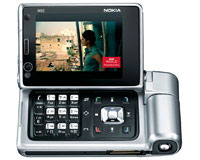 Nokia has announced a partnership with TeliaSonera Sweden to trial a complete DVB-H system, using Nokia’s Nordic know-how, their Mobile Broadcast System 3.0 and Nokia N92 mobile TV devices.
Nokia has announced a partnership with TeliaSonera Sweden to trial a complete DVB-H system, using Nokia’s Nordic know-how, their Mobile Broadcast System 3.0 and Nokia N92 mobile TV devices.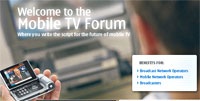 “Nokia is very pleased to be working so closely with TeliaSonera Sweden in this new area of DVB-H based mobile TV. We believe strongly in the capability of this technology as well as in the mobile TV service, and we are looking forward to verify the full potential of mobile TV together with TeliaSonera Sweden,” purred Jan Lindgren, Vice President, Networks, Nokia.
“Nokia is very pleased to be working so closely with TeliaSonera Sweden in this new area of DVB-H based mobile TV. We believe strongly in the capability of this technology as well as in the mobile TV service, and we are looking forward to verify the full potential of mobile TV together with TeliaSonera Sweden,” purred Jan Lindgren, Vice President, Networks, Nokia. About the technology
About the technology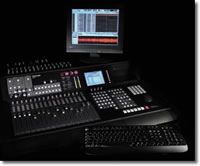 We’re frequently impressed with the observations of Marc Freedman from
We’re frequently impressed with the observations of Marc Freedman from  As illustrated, average weekly sales during the first four-week periods of 2006 decline from 17.56 million units/week in the 1st period to 16.68 million units/week in the 4th period (a drop of .9 million units or 5.1%). Compare this to average weekly sales for the first four-week periods of 2005 when average weekly sales grew from 7.38 million units/week in the 1st period to 8.73 million units/week in the 4th period (an increase of 1.4 million units or 18.3%).
As illustrated, average weekly sales during the first four-week periods of 2006 decline from 17.56 million units/week in the 1st period to 16.68 million units/week in the 4th period (a drop of .9 million units or 5.1%). Compare this to average weekly sales for the first four-week periods of 2005 when average weekly sales grew from 7.38 million units/week in the 1st period to 8.73 million units/week in the 4th period (an increase of 1.4 million units or 18.3%). Digital music sales rose to a point where they essentially offset the decline in CD sales in 2005. (Bainwol was right on that point, but that was for last year.) With the hypergrowth behind it, digital music sales can no longer make up for the hemorrhaging of physical music sales nor will it return the music industry to its prior glory days.
Digital music sales rose to a point where they essentially offset the decline in CD sales in 2005. (Bainwol was right on that point, but that was for last year.) With the hypergrowth behind it, digital music sales can no longer make up for the hemorrhaging of physical music sales nor will it return the music industry to its prior glory days. Unlike the transition from albums to CDs or video tapes to DVD, ‘going digital’ is not a simple format media transition. The use of digital technologies and the Internet has and will continue to fundamentally change how entertainment is created, stored, distributed, and consumed. Technology has undermined the entertainment industry’s pretense of control despite its best efforts.
Unlike the transition from albums to CDs or video tapes to DVD, ‘going digital’ is not a simple format media transition. The use of digital technologies and the Internet has and will continue to fundamentally change how entertainment is created, stored, distributed, and consumed. Technology has undermined the entertainment industry’s pretense of control despite its best efforts.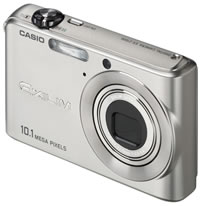 Just how much resolution do you need? Ten million pixels is a lot of information by any conventional measure, especially since most consumers rarely print out images larger than traditional 10x15cm enprints. That requires no more than the three megapixel sensors found on today’s very cheapest cameras, and now even high-end cameraphones.
Just how much resolution do you need? Ten million pixels is a lot of information by any conventional measure, especially since most consumers rarely print out images larger than traditional 10x15cm enprints. That requires no more than the three megapixel sensors found on today’s very cheapest cameras, and now even high-end cameraphones. Around the back, a bright 2.8-inch widescreen LCD monopolises the available space. Only 2.5-inches is available for framing – the remainder is taken up by a fantastic vertical menu strip for instantly tweaking image size, quality, metering and more. Creative features are eclectic rather than comprehensive: a continuous flash mode shoots three flash shots in a second, and there are more pre-programmed scene modes than even the most bored teenager could wade through.
Around the back, a bright 2.8-inch widescreen LCD monopolises the available space. Only 2.5-inches is available for framing – the remainder is taken up by a fantastic vertical menu strip for instantly tweaking image size, quality, metering and more. Creative features are eclectic rather than comprehensive: a continuous flash mode shoots three flash shots in a second, and there are more pre-programmed scene modes than even the most bored teenager could wade through. Verdict
Verdict eBay has announced that it will start integrating Skype’s VoIP service with its U.S. auction site next week (as
eBay has announced that it will start integrating Skype’s VoIP service with its U.S. auction site next week (as  Bill Cobb, president of eBay’s North American auction business reckons they’re on to a winner with this one: “Skype represents a tremendous opportunity for our sellers to connect even more closely with their buyers,” he insisted.
Bill Cobb, president of eBay’s North American auction business reckons they’re on to a winner with this one: “Skype represents a tremendous opportunity for our sellers to connect even more closely with their buyers,” he insisted.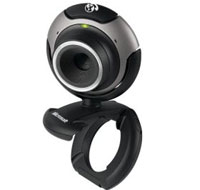 Microsoft has slipped out a pair of branded Webcams designed to offer tight integration with their hideously popular Messenger service.
Microsoft has slipped out a pair of branded Webcams designed to offer tight integration with their hideously popular Messenger service. Both cams also come with built in mics, a wide angle lens to let social butterflies fit their vast armies of chums in frame and built-in cheesy video effects like falling snowflakes or twinkling stars.
Both cams also come with built in mics, a wide angle lens to let social butterflies fit their vast armies of chums in frame and built-in cheesy video effects like falling snowflakes or twinkling stars.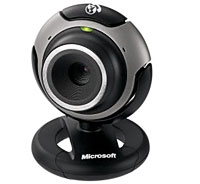 Here’s Microsoft’s Consumer Productivity Experiences Executive Vice President (who dreams up these job titles?) Tom Gibbons to explain how LifeCams are part of a new initiative by his company to tie in hardware products to Windows Live services.
Here’s Microsoft’s Consumer Productivity Experiences Executive Vice President (who dreams up these job titles?) Tom Gibbons to explain how LifeCams are part of a new initiative by his company to tie in hardware products to Windows Live services.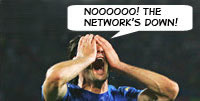 According to Internet research firm Nielsen/NetRatings, the BBC Sport Website is the most popular online source for World Cup news in the UK, with over 1.3 million footie fans visiting the site in the first week of the tournament.
According to Internet research firm Nielsen/NetRatings, the BBC Sport Website is the most popular online source for World Cup news in the UK, with over 1.3 million footie fans visiting the site in the first week of the tournament.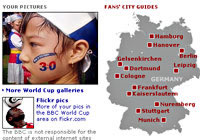 “The large audience figures for the weekend shows the major advantages the Internet has in on-demand content,” he added.
“The large audience figures for the weekend shows the major advantages the Internet has in on-demand content,” he added. Mike Hemes, country manager for UK and Ireland at Packeteer, reckons that the bandwidth-busting footie action could cause big problems for IT managers, commenting: “It is likely that millions of workers will log on to watch matches due to faster Internet connections at work than at home …this will generate a huge surge in network traffic, eating into the bandwidth available to run business-critical applications effectively.”
Mike Hemes, country manager for UK and Ireland at Packeteer, reckons that the bandwidth-busting footie action could cause big problems for IT managers, commenting: “It is likely that millions of workers will log on to watch matches due to faster Internet connections at work than at home …this will generate a huge surge in network traffic, eating into the bandwidth available to run business-critical applications effectively.” Legally, a TV licence is required for any device that is “installed or used” for receiving television broadcasts, so that a networked PC used for streaming games needs a licence as well as the gogglebox at home.
Legally, a TV licence is required for any device that is “installed or used” for receiving television broadcasts, so that a networked PC used for streaming games needs a licence as well as the gogglebox at home. If watching the World Cup on TV,
If watching the World Cup on TV,  If you specify an
If you specify an 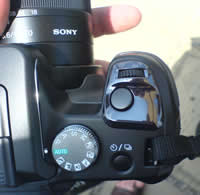 We had our hands on the Sony Alpha A100 last week, Sony’s first step into the Digital SLR (dSLR) market.
We had our hands on the Sony Alpha A100 last week, Sony’s first step into the Digital SLR (dSLR) market.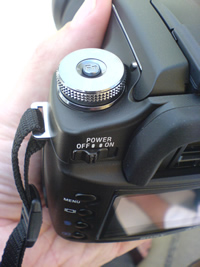 What’s Hot
What’s Hot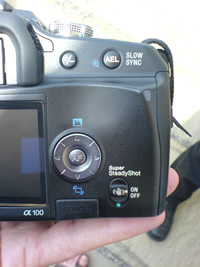 First impressions
First impressions


 Think carefully the next time you edit your Flickr or Myspace profile.
Think carefully the next time you edit your Flickr or Myspace profile.  In September 2005 the European Commission adopted a proposal that would see telecommunications data held for one year and Internet data for six months and, last month, the European Court annulled the agreement which compelled airlines to submit private data on passengers flying to the US.
In September 2005 the European Commission adopted a proposal that would see telecommunications data held for one year and Internet data for six months and, last month, the European Court annulled the agreement which compelled airlines to submit private data on passengers flying to the US. Word is spreading that the long-antcipated integration of Skype into eBay’s auction site is close at hand.
Word is spreading that the long-antcipated integration of Skype into eBay’s auction site is close at hand. Skype recently introduced Skypecasting, the ability to broadcast to up to 100 Skype users. While it’s being used for a wide variety of innovative application such as learning of languages and small music concerts, we see the eBay-centric usage being live auctions.
Skype recently introduced Skypecasting, the ability to broadcast to up to 100 Skype users. While it’s being used for a wide variety of innovative application such as learning of languages and small music concerts, we see the eBay-centric usage being live auctions.